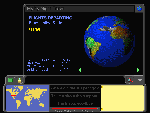Educational software - August '97
Where In The World Is Carmen San Diego 3.0
Age range: 4 years to adult
Skills: Geography
List price: $69.95
Minimum system requirements: Windows 95, 486DX/33, 8Mb RAM, 32Mb hard
disk space, CD-ROM, 256 colours, mouse, soundcard. Available for Mac.
From: Dataflow http://www.dataflow.com.au
Publisher: Broderbund http://www.broder.com/education/
Relevance to Australia: ![]()
![]()
![]()
![]()
Suitability to schools: ![]()
![]()
![]()
![]()
Friendliness: ![]()
![]()
![]()
![]()
Multimedia: ![]()
![]()
![]()
![]()
![]()
Overall value: ![]()
![]()
![]()
![]()
The latest edition of Where In The World Is Carmen San Diego covers players aged four to adult. Though Carmen San Diego Junior is better to run with if your children are in early primary school, version 3.0 offers older students and families fine entertainment as well as teaching world geography and research.
Compared with previous versions, the graphics are more powerful. As you pursue the notorious Carmen through the world, from museum to airport, train station to art gallery, you can now immerse yourself by taking a 360 degree walking tour through each location and experience the local culture.
To help decipher clues, the database, which is now online rather than in an almanac, covers 50 countries. And it is substantial offering videos, photographs, short essays and geopolitical maps. It even offers a Carmen San Diego ACME Detective agency Internet Headquarters Web site designed to provide access to geography resources published on the World Wide Web. Fasten your seatbelt super sleuths and look out Carmen!
Demo not available
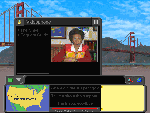
Age range: 8 to 12 years
Skills: Social studies
List price: $79.95
Minimum system requirements: Windows 3.1, 486SX, 8Mb RAM, 8Mb hard disk space, 2X CD-ROM, soundcard, 256 colours. Available for Mac.
From: Dataflow http://www.dataflow.com.au
Publisher: Soleil http://www.soleil.com/
Relevance to Australia:
Suitability to schools:
Friendliness:
Multimedia:
Overall value:
World Walker: Destination Australia is an unusual package combining a Walkabout game of Australian animals, a food chain game and a sentence construction task in English, French and Spanish. I played with an eight- and 13-year-old student.
On first entering World Walker directions were foggy, but a tentative click on footprints on the menu bar took us to a Walkabout screen depicting the Australian outback crammed with animals. From here the Help screen text advised that we could explore the outback by following the arrows and clicking on animals to hear their names. Alternatively we could select an animal search assignment.
Our written assignment -- pitched at approximately a 10-year-old reading level, was to find "a very large raptor with feathered legs and a wing span of nearly 10 feet". We located it and clicked on it to earn batteries to power our torch and explore the caves. The Walkabout section of the game, though the animal pictures lacked animation, was interesting and educational. The cave exploration section, however, seemed to have a bug, for although the map indicated we should go South, the screen only allowed us to move East or West.
Next we used the menu bar to jump to Food Chain Solitaire. This complex predator/prey card game greeted us with welcome verbal instructions. By playing this we could theoretically learn the answers to questions such as 'Who eats what for dinner?'
The third game, Language Explorer, is independent of the Australian theme. You explore house and street scenes, point to objects and their name appears written and spoken in the language you have chosen. You drag-and-drop fragments to form complete sentences and click to hear them read. An excellent game for beginning French, English and Spanish students.
World Walker: Destination Australia is more suited to 10- to 13-year-olds than eight-year-olds. It could be improved by having Australian metric measures, a verbal orientation at the start of the game, animation of animal pictures, 'Return to Previous Screen' buttons, a menu bar that stayed entirely visible on each screen, and tips and solutions after three or more incorrect moves.
Overall, for primary school students, Walkabout and Language Explorer are valuable activities and offer sound value for money.
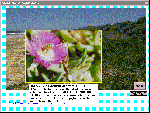
Oz Ecology
Age range: 13+ years
Skills: Australian ecosystems
Relevance to Australia: ![]()
![]()
![]()
![]()
![]()
Suitability for school: ![]()
![]()
![]()
![]()
![]()
Interest: ![]()
![]()
![]()
![]()
Friendliness: ![]()
![]()
![]()
![]()
Multimedia: ![]()
![]()
![]()
![]()
Overall value: ![]()
![]()
![]()
![]()
From: Synergy Solutions (02) 9689 1233
Publisher: Synergy Solutions http://www.ozemail.com.au/~mlennon
List price: $90; Site $239
System requirements: Windows 3.1, 386, 4Mb RAM, SVGA, mouse, 6Mb hard
disk space, 3.5in drive
Oz Ecology and Dinner Time are both targeted at the Australian secondary school science syllabus. Accurate and easy to use, they slot effortlessly into class activities.
Oz Ecology aims to supplement senior biology field trips (mandatory in NSW and part of Biology curriculums Australia-wide), but can also be profitably played by students in lower secondary and upper primary classes.
Using Oz Ecology, students can review three main Australian environments: Rainforest, Sand Dunes and Rocky Shelves. The program emphasises plant and animal adaptations to the physical environment and how physical factors determine the distribution of organisms within an ecosystem. In each environment you click on organisms to access close-up photographs and accompanying text. You then check out distribution patterns and abiotic (non-living) factors, such as how the tide benefits creatures on rock platforms, the mechanisms dune plants have evolved to survive being buried by sand, how solar heating results in higher temperatures and lower dissolved oxygen levels in rock pools, and why coastal rainforests are always located behind sand dunes.
In the Rocky Shelves Food Web activity you place an algae, morula, dead organism, starfish and a limpet in an aquarium a couple at a time to test which eats the other. Then complete the food web by dragging organisms to their correct location.
Each ecosystem has accompanying tutorials, work sheets and an interactive quiz. Ideal for revision, the quiz requires students to match photographs with their descriptions, and drag correct words to complete sentences, to assess how well they have grasped key concepts.
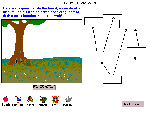
Dinner Time
Age range: 11 to 15 years
Skills: Australian ecosystems
Relevance to Australia: ![]()
![]()
![]()
![]()
![]()
Suitability for school: ![]()
![]()
![]()
![]()
![]()
Interest: ![]()
![]()
![]()
![]()
Friendliness: ![]()
![]()
![]()
![]()
Multimedia: ![]()
![]()
![]()
![]()
Overall value: ![]()
![]()
![]()
![]()
From: Synergy Solutions (02) 9689 1233
Publisher: Synergy Solutions http://www.ozemail.com.au/~mlennon
List price: $90; Site $239
System requirements: Windows 3.1, 386, 4Mb RAM, SVGA, mouse, 6Mb had disk
space, 3.5in drive
Dinner Time aims to assist ecology teaching in Years 7 to 10. Students employ observation and problem solving skills to solve puzzles of an ecological nature, such as interactive food webs.
Dinner Time topics cover food webs, producers, consumers (carnivores, herbivores and omnivores), trophic levels and energy loss, teeth type (canines, incisors, molars) and diet, and comparative vision in prey and predators.
The program offers three habitats: Forest, Rocky Shore and Mangroves.
The Forest Food Web features a lyre-bird, insect, python, owl and mouse. You release organisms into the forest a couple at a time, study to see which eats the other, then use this information by clicking on and dragging the organism to its place in the food web.
Overall, Dinner Time is easy to use, informative and an enjoyable way to reinforce ecology concepts.
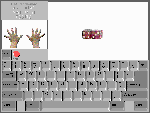
Animated Beginning Typing
Author: Tom Guthery IV
Registration: $14
URL: http:\\www.eden.com\~flixprod\set_type.exe
Rating: ![]()
![]()
![]()
![]()
Animated Beginning Typing teaches touch-typing in an entertaining way. Teaching activities include letter jumpers, letter drill, flying letters and a typing tutorial. At the end of each game the program reports on the number of words typed per minute, how long the game took you, and the number of mistakes you made. Colourful animations and graphics and clear explanations combine to bring you one step closer to being a touch-typist.
All these shareware programs are available on this month's PC User Offline CD-ROM and the School PC Web page at www.schoolpc.acp.com.au.
by Alan Hilvert-Bruce
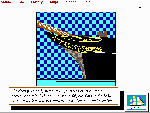
Author: ABC Software
Registration: $20
URL: http://www.eyvee.com/ccshare.zip
Rating: 4/5
In 1833 Britain allowed merchants to use foreign vessels to carry Chinese cargo to non-British ports. So begins Chinese Clippers, a shareware program devoted to the Clippers who traded with China and the tea trade.
There are three main sections: Tea, History and Marine, with sub-sections Ships and Action.
Tea covers the demand for tea, the growing regions, the plant, the manufacture and the transport. History includes time-lines, captains, tea races and countries. Ships includes famous hull detail, sail plans and rigging, speed and vessel names. You can find, for example, illustrations of the James Baine, the fastest clipper ship ever, and the Cutty Sark. Marine includes sailing routes, navigation tools, dangers (including information on ships Dismasted, Aground and Vanished) and charts. Action includes a tutorial and finally a quiz to test your knowledge.
With beautiful graphics, and a simple interface, Chinese Clippers is a fine reference for primary school projects.
Authors: Nancy Ayash and Bill Dedes
Registration: $20
URL: ftp://ftp.surfnet.nl/surfdiensten/server/aquest40.zip
Rating: 2.5/5
In Animal Quest 4 you play different animals of your choice as you hunt or be hunted by other animals. Your aim is to live and eat as much as you can. Your choice of animal affects how easy the game is. For example, if you pick a bear, which eats nearly everything and is not hunted seriously, the game is easy. On the other hand, if you pick a frog, which eats no other animals and gets eaten by others, the game is extremely hard.
The shareware version of Animal Quest features bush animals and the registered version adds ocean, jungle and forest animals, plus a young lion campaign.
With excellent music and simple rules, Animal Quest 4 is a game to entice seven- to 11-year olds.

Author: Tom Guthery IV
Registration: $10
URL: ftp://ftp.pht.com/.4/brainstorm/childed/math/amath.zip
Rating: 3.5/5
Animated Math is an introductory maths program for ages three to six. Math activities include counting objects, multiple choice and addition. For each correct answer you give, you are rewarded with a short animation. Answer 10 questions correctly and you can choose from activities such as colouring, dinosaurs, piano and making a rocket.
The interface is basic enough for preschoolers and the colourful graphics will keep them wide-eyed and amused.
Previous PC User Offline CD's
Top of page |
WEB: |What's New
| Net Guides | Web Workshop | Net Sites | About PC User |
|
